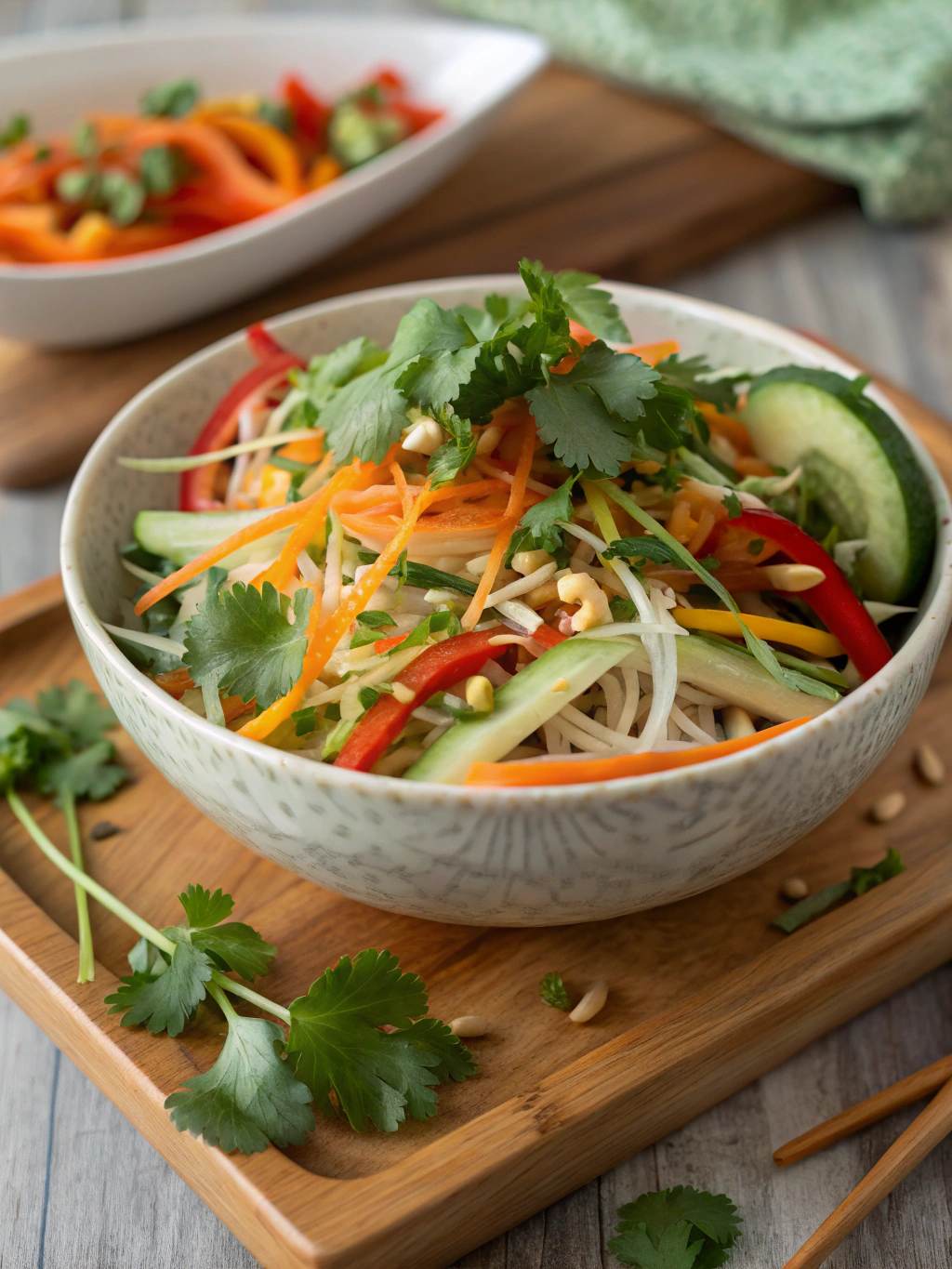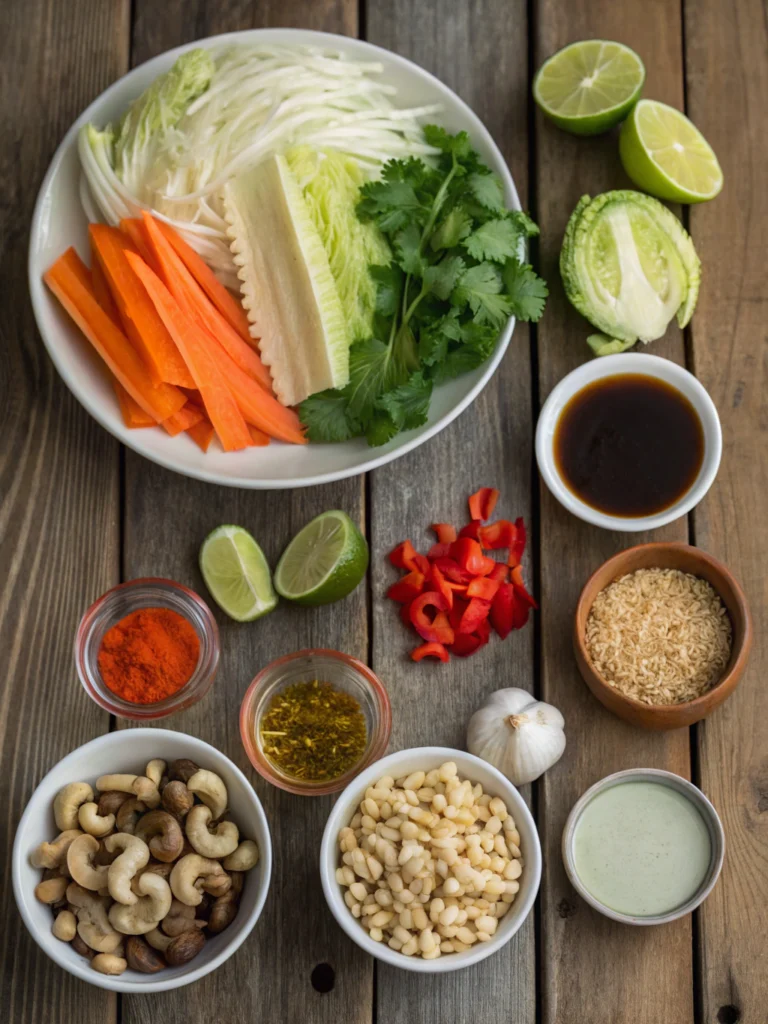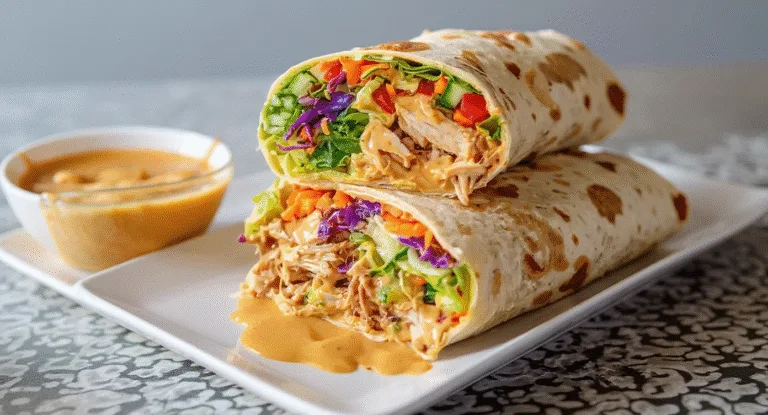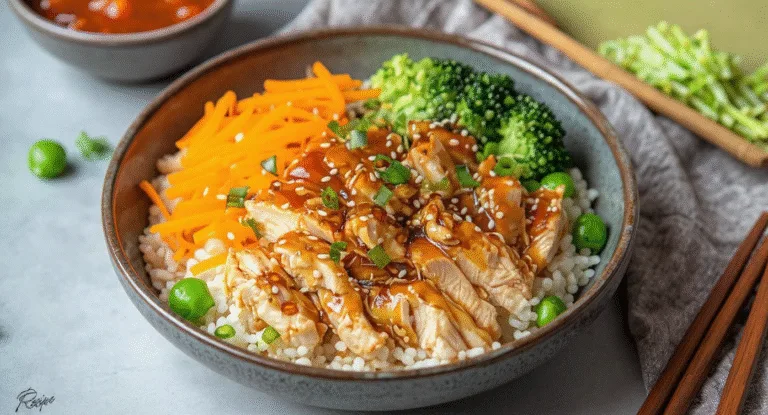Our Best Asian Salad Recipe You’ll Make Again and Again

Are you on the hunt for a salad that truly awakens your palate? Fed up with uninspiring greens and predictable dressings that fail to spark any joy? Well, allow us to introduce you to something special! We’re thrilled to share our method for crafting an utterly sensational Asian salad, one that’s a feast for the eyes with its vivid colours, a delight with its varied textures, and unforgettable thanks to its incredible dressing. This is more than just a salad; it’s a culinary adventure, a tapestry of tastes that will have you eagerly anticipating your next serving. We’re confident that once you’ve experienced this recipe, it’ll earn a cherished spot in your cooking collection.
What Makes an Asian Salad So Special?
What distinguishes an Asian salad from its Western cousins? It’s primarily the exquisite harmony of tastes and textures. Imagine that perfect balance: the savoury depth of soy sauce, a lively zest from rice vinegar, a delicate sweetness, often a subtle warmth from spice, and the fragrant nuttiness of sesame oil. Asian salads are typically brimming with an assortment of crunchy vegetables, often thinly sliced or cut into matchsticks, and garnished with fresh herbs like coriander or mint. They are conceived to enliven the senses and offer a genuinely invigorating eating experience. We observe that the dressings tend to be lighter and more piquant compared to their creamy, heavier counterparts, letting the fresh components truly take centre stage.
Why You’ll Adore This Particular Asian Salad Recipe
Having experimented with numerous versions, we find this specific Asian salad recipe particularly compelling for several key reasons. Firstly, its flavour profile is impeccably balanced – it’s a delightful mix of savoury, sweet, and tangy, and you can easily tailor the spice level to your liking.
Secondly, its versatility is outstanding. Whether you follow a vegetarian, vegan, or meat-inclusive diet, this recipe can be readily adapted to meet your dietary requirements and personal tastes. Thirdly, it’s all about that satisfying crunch! The interplay of fresh, crisp vegetables with toasted nuts or seeds provides a delightful texture that makes each mouthful captivating. And finally, it’s simply a joy to behold – a kaleidoscope of colours that is as appealing to the eye as it is to the taste buds.
Ingredients for Your Vibrant Asian Salad
To assemble this culinary delight, we’ll require an array of fresh components for both the salad base and that crucial, flavour-packed dressing. Please don’t feel daunted by the ingredient list; many are common pantry items, and the fresh vegetables are widely available.

For the Salad Base:
- Napa Cabbage (Chinese Cabbage): Roughly ½ a medium head, sliced thinly. Its delicate crispness is perfect.
- Red Cabbage: Approximately ¼ of a small head, sliced thinly for visual appeal and bite.
- Carrots: 2 medium-sized, cut into julienne strips or coarsely shredded.
- Bell Pepper: 1 red or yellow, thinly sliced to add sweetness and vibrancy.
- Cucumber: ½ a large one, with seeds removed and thinly sliced or cut into semi-circles.
- Spring Onions: 3-4, sliced thinly (using both the white and green sections).
- Edamame Beans: 1 cup, shelled (ensure they are cooked and cooled if you’re using frozen ones).
- Fresh Coriander: A good handful, coarsely chopped.
- Fresh Mint: A small handful, leaves picked and coarsely chopped (optional, but adds a lovely freshness).
- Toasted Sesame Seeds: 2 tablespoons, to garnish.
- Chopped Peanuts or Cashews: ¼ cup, toasted, for an optional garnish.
For the Zingy Asian Dressing:
- Rice Vinegar: ¼ cup (60ml). This imparts the necessary sharpness.
- Soy Sauce: 3 tablespoons (45ml). Opt for tamari if you need a gluten-free alternative.
- Toasted Sesame Oil: 2 tablespoons (30ml). This oil has a potent, nutty character, so use it judiciously.
- Honey or Maple Syrup: 1-2 tablespoons (15-30ml), adjust according to your desired sweetness. Maple syrup ensures it’s vegan-friendly.
- Fresh Ginger: 1 tablespoon, grated very finely.
- Fresh Garlic: 1-2 cloves, minced or grated very finely.
- Lime Juice: 1 tablespoon (15ml), freshly squeezed to add brightness.
- Optional Heat: ½ – 1 teaspoon of sriracha, a small pinch of red chilli flakes, or one finely chopped red chilli.
Essential Equipment You’ll Need
Excellent news! You won’t require any elaborate kitchen tools for this Asian salad recipe. Here’s what we suggest having ready:
- A high-quality, sharp knife for all the necessary chopping and slicing.
- A robust chopping board.
- A generously sized mixing bowl – ample enough for tossing the salad with ease.
- A small bowl, or a jam jar equipped with a lid, for preparing and mixing the dressing.
- A whisk (if you’re not using a jar for the dressing).
- Standard measuring cups and spoons.
- Optional: A mandoline slicer can expedite the process of shredding cabbage and slicing vegetables thinly and evenly. A grater is also handy for the carrots and ginger.
Step-by-Step Guide to Crafting the Perfect Asian Salad
Now we reach the enjoyable stage – assembling everything! We’ve simplified the process into easy-to-follow steps.
- Prepare All Your Vegetables: This step requires the most time, but the effort is well rewarded. Thoroughly wash all your vegetables. Thinly shred the Napa and red cabbage. Julienne carrots (thin, matchstick-like pieces) are ideal, though coarse grating also works. Slice the bell pepper and spring onions thinly. Remove the seeds from the cucumber (this helps prevent a watery salad) and then slice it. If you’re using frozen edamame, cook as per the packet directions, then allow to cool.
- Chop the Herbs: Coarsely chop the fresh coriander and mint (if you’ve chosen to include it). Reserve a small amount for garnishing later.
- Toast Nuts/Seeds (if using): If your sesame seeds or nuts are not already toasted, this can be done swiftly. Place them in a dry frying pan over a medium heat for a couple of minutes, agitating the pan often, until they become fragrant and lightly browned. Keep a close eye on them, as they can scorch easily! Take them off the heat and let them cool down.
- Make the Zingy Asian Dressing: In your small bowl or jar, combine all the ingredients for the dressing: rice vinegar, soy sauce, sesame oil, honey or maple syrup, grated ginger, minced garlic, and lime juice. Introduce your chosen source of heat here as well. Whisk energetically or, if using a jar, seal the lid firmly and shake vigorously until all components are emulsified (thoroughly blended). It’s vital to taste it at this point! Does it require more sweetness? A sharper tang? A touch more saltiness (from the soy sauce)? Adjust it to suit your preference.
- Combine and Toss (Just Before Serving): In your large mixing bowl, introduce all the prepared vegetables (cabbage, carrots, bell pepper, cucumber, spring onions, edamame) and the majority of the chopped herbs. Pour approximately two-thirds of the dressing over the salad. Gently mix everything together until the vegetables are uniformly coated. You’re aiming for them to be glistening, not saturated in dressing. Add more dressing if necessary, a small amount at a time.
- Garnish and Serve Immediately: Transfer the salad to a serving dish or individual bowls. Scatter the toasted sesame seeds, chopped nuts (if you’re using them), and the reserved fresh herbs over the top. Serve at once to enjoy the optimal crunch and flavour.
Watch: How to Make a Simple Asian Salad
Sometimes, a visual demonstration makes all the difference in learning! Here’s an excellent video from Marion’s Kitchen illustrating how to prepare an everyday Asian salad with a simple dressing. It’s particularly helpful for visual learners and offers some lovely creative ideas:
We believe that viewing a brief tutorial can greatly assist in understanding the steps and boosting your confidence in the kitchen.
Top Tips for an Unforgettable Asian Salad
We are keen for your Asian salad creation to be truly exceptional. Here are some additional pointers we’ve gathered from our experiences:
- Freshness is Paramount: The superior quality of your ingredients directly translates to a more delicious salad. Opt for the freshest, most crisp vegetables available.
- Texture is Key: Strive for a diverse range of textures. The blend of crunchy cabbage, crisp carrots, softer edamame, and firm nuts creates a wonderful sensation in the mouth. Avoid over-chopping; distinct pieces are desirable.
- Dress Just Before Serving: This is a cardinal rule for most salads, particularly those featuring delicate leaves or finely shredded components. Dressing too soon will lead to the vegetables wilting and becoming limp.
- Taste and Adjust Religiously: Everyone’s palate is different. Always sample the dressing before adding it to the salad and fine-tune the seasonings (sweetness, sourness, saltiness, spiciness) as required. Taste the salad after tossing it too!
- Prep Ahead for Ease: You can chop most of the vegetables (though perhaps not cucumber, as it can release water) and prepare the dressing a day beforehand. Keep them stored separately in airtight containers in the refrigerator. This significantly speeds up assembly when you’re ready to eat.
- Don’t Drown Your Salad: Begin with a smaller quantity of dressing than you might anticipate needing. You can always introduce more, but it’s impossible to remove it once it’s mixed in.
Delicious Variations to Try
One of the most appealing aspects of this Asian salad recipe is its inherent adaptability. We encourage you to unleash your creativity! Here are some of our much-loved variations:
Turning it into an Asian Coleslaw
To morph this into a more conventional asian coleslaw, we place greater emphasis on the cabbage and carrots. You might consider using a dressing with a slightly creamier consistency. Try incorporating a tablespoon or two of mayonnaise (Japanese Kewpie mayonnaise is wonderful for this) or a vegan alternative into the existing dressing recipe. This will impart that characteristic coleslaw richness while preserving the lively Asian tastes. Ensure your cabbage and carrots are shredded very finely to achieve the ideal coleslaw texture.
Adding Quick Asian Pickled Cucumbers
For an additional dimension of tangy crispness, think about preparing some quick asian pickled cucumbers. They are remarkably simple to make:
- Thinly slice one small cucumber (or half of a large one). Kirby cucumbers are a good choice.
- In a small bowl, combine 2 tablespoons of rice vinegar, 1 teaspoon of sugar, and a pinch of salt. You might also add a tiny splash of sesame oil or a few chilli flakes.
- Introduce the cucumber slices, toss them to ensure they are coated, and allow them to rest for at least 15-30 minutes at room temperature (or for a longer period in the fridge).
You can then drain them gently and incorporate them into your main salad, or offer them as a side. This also serves beautifully as an element in a pickled cucumber salad by itself.
Making a Refreshing Pickled Cucumber Salad as a Side
If the notion of pickles appeals to you, why not create a dedicated pickled cucumber salad to accompany your main course? For a slightly more substantial version than the quick pickles mentioned above, thinly slice 2-3 cucumbers. Toss them with a dressing composed of ¼ cup rice vinegar, 1 tablespoon soy sauce, 1 tablespoon sesame oil, 1-2 teaspoons sugar (or to your taste), a pinch of salt, and a sprinkle of toasted sesame seeds. Finely minced garlic or ginger can also be included. Let it marinate for a minimum of 30 minutes. This is exceptionally refreshing and provides an excellent contrast to richer dishes.
Protein Power-Ups
Transform this salad into a well-rounded meal by incorporating some protein:
- Grilled Chicken or Turkey: Sliced or shredded cooked chicken breast or turkey meat.
- Prawns: Cooked and cooled prawns make a delightful addition.
- Tofu or Tempeh: Pan-fried, baked, or grilled firm tofu or tempeh, perhaps pre-marinated in a little soy sauce and ginger.
- Salmon: Flaked, cooked salmon (whether grilled or poached) complements it beautifully.
Noodle Boost
Elevate it into a more filling noodle salad by adding cooked and cooled noodles such as:
- Soba (buckwheat) noodles
- Rice vermicelli
- Glass noodles (mung bean noodles)
You may find you need to prepare a little extra dressing if you introduce a significant quantity of noodles.
Fruity Twist
For an injection of sweetness and a different textural element, consider including:
- Mandarin orange segments (canned and drained, or fresh)
- Diced ripe mango
- Pomegranate seeds for a jewel-like quality and a burst of flavour.
What to Serve With Your Asian Salad
This adaptable Asian salad recipe can be savoured in numerous contexts:
- As a light and invigorating main course on its own, particularly when enhanced with protein.
- As a colourful side dish accompanying grilled fish (such as salmon or sea bass), chicken satay, or barbecued meats.
- With Asian-themed dishes like spring rolls, gyoza (dumplings), or a simple stir-fry.
- As part of a larger buffet or potluck selection – it invariably proves popular!
Following such a refreshing meal, you might even fancy a simple dessert. A slice of classic Banana Bread can offer a comforting conclusion, or for a lighter alternative, our Sugar-Free Banana Bread is an excellent choice. It’s all about finding that perfect balance, isn’t it!
Storing Leftovers (If You Have Any!)
Ideally, this Asian salad is best relished fresh, immediately after being tossed with the dressing. Its crunchiness is at its prime at that moment. However, should you find yourself with leftovers:
- Undressed Salad: If you’ve kept the salad ingredients and dressing separate, the chopped vegetables can be kept in an airtight container in the fridge for 2-3 days. The dressing will remain in good condition in a sealed jar in the fridge for up to a week.
- Dressed Salad: Once dressed, the salad will gradually lose its crispness. It will still be palatable the following day, but anticipate it being somewhat softer. Store it in an airtight container in the fridge and aim to consume it within 24 hours.
Exploring Asian Ingredients Further
Many of the components featured in our Asian salad dressing, such as soy sauce, rice vinegar, and sesame oil, are integral to numerous Asian culinary traditions. Gaining a deeper understanding of these can truly enhance your cooking. For those interested in establishing a well-appointed pantry for more Asian-inspired culinary adventures, BBC Good Food provides a superb summary of essential ingredients, many of which are versatile across different Asian cuisines and will prove useful far beyond this salad.
Frequently Asked Questions (FAQ)
Q1: Can I make this Asian salad recipe gluten-free?
A: Indeed, you can! The primary ingredient requiring attention is soy sauce. Simply replace it with tamari (which is generally gluten-free, though it’s always wise to check the label) or coconut aminos. Also, ensure any other pre-prepared ingredients you might incorporate are certified gluten-free.
Q2: How can I make the salad spicy?
A: There are multiple approaches! You could add sriracha or a pinch of red chilli flakes to the dressing. Alternatively, thinly slice a fresh red or green chilli (remove the seeds if you prefer less intensity) and add it directly to the salad. Adjust the quantity to suit your heat preference.
Q3: Can I prepare the salad ahead of time?
A: Yes, a significant portion of the preparation can be done in advance. Chop all the vegetables and keep them in an airtight container in the refrigerator. The dressing can also be prepared beforehand and stored in a separate, sealed jar in the fridge. Only combine the vegetables and dressing when you are ready to serve, to preserve maximum crispness.
Q4: What’s the best cabbage for an Asian salad?
A: We are particularly fond of Napa cabbage (also referred to as Chinese cabbage) due to its tender-crisp quality and subtly sweet taste. Red cabbage is splendid for introducing vibrant colour and a more pronounced crunch. Savoy cabbage or even standard white cabbage can also be effective if shredded finely.
Q5: How long will the Asian salad dressing last in the fridge?
A: When stored in an airtight container or jar, the dressing should keep well for up to one week in the refrigerator. Ensure you give it a thorough shake or whisk before use, as the ingredients might have separated.
Q6: Can I use different nuts or seeds?
A: Certainly! While toasted sesame seeds and peanuts are traditional choices, we encourage you to experiment. Toasted cashews, slivered almonds, sunflower seeds, or pumpkin seeds would all be tasty additions and contribute varied textural qualities.
Ready to Create Your Own Salad Masterpiece?
We trust we’ve sparked your enthusiasm to explore the delightful realm of fresh, flavour-packed Asian salads! This recipe serves as more than mere instructions; it’s a blueprint for crafting something genuinely delicious and fulfilling. The fusion of crisp vegetables, fragrant herbs, crunchy garnishes, and that captivatingly zesty dressing is consistently a triumph. It’s wholesome, it’s colourful, and it’s remarkably straightforward to assemble.
We warmly encourage you to give this superb Asian salad recipe a try. Be inventive with the ingredients, adapt it to your preferences, make it uniquely yours, and, most importantly, savour the creative process and the delectable outcome. We would be delighted to hear about your experience and any personal modifications you introduce, so please do share your thoughts in the comments section below!
Remember to bookmark this page for your next salad inclination or whenever you require a swift, nutritious, and impressive dish. Happy salad crafting!







One Comment
Comments are closed.